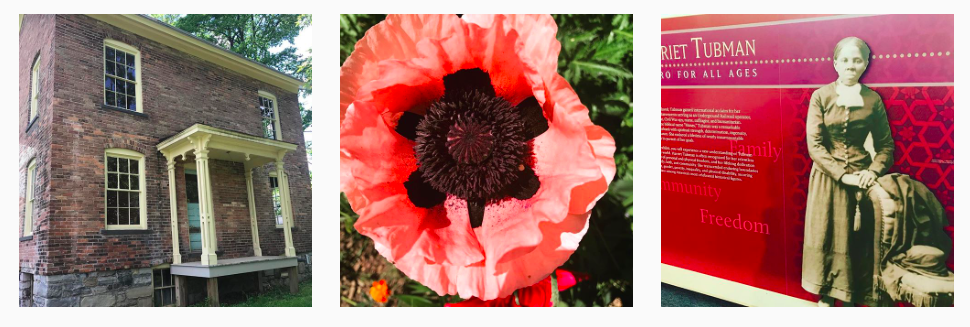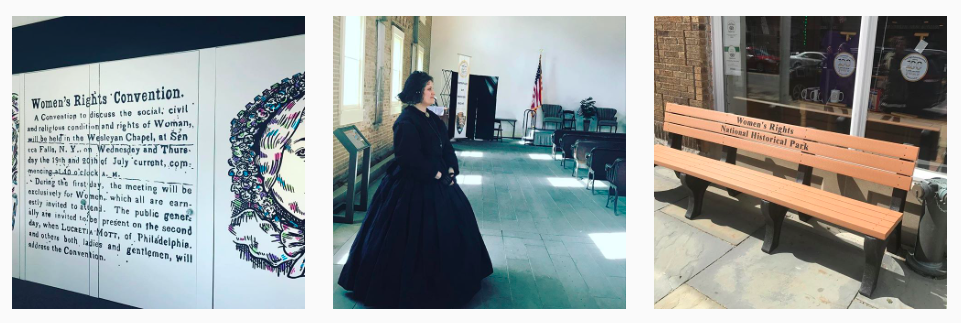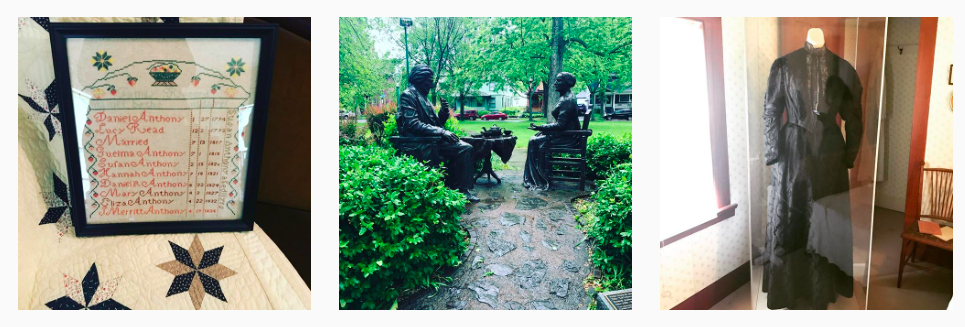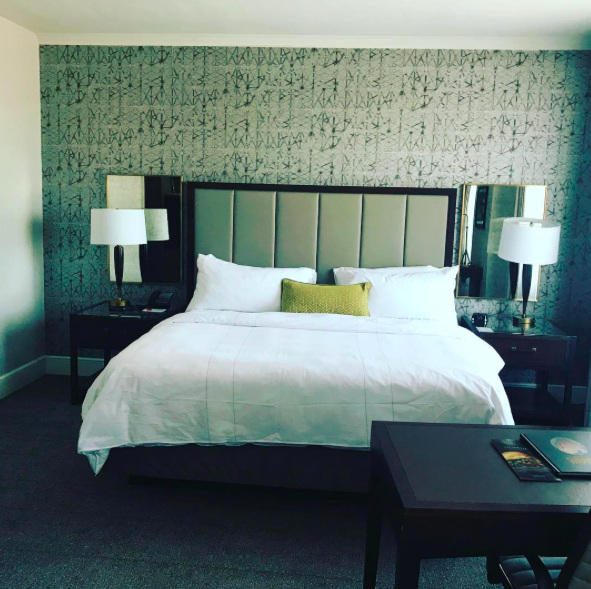Last week I took a trip through the Finger Lakes in Upstate New York and found a plethora of women’s history to explore and trace. It was a pleasant surprise, given that I hadn’t been to these particular parts of New York. Add that to my genuine interest in women’s rights and human rights. It was amazing how in just a short few days, I would walk in the footsteps of so many incredible suffragettes’ steps who changed the course of women’s history forever.
I started my journey in Syracuse where I visited the Matilda Joslyn Gage Home and learned about the origins of the National Women Suffrage Association; in Auburn I learned the history of the famous abolitionist and humanitarian Harriet Tubman at the Harriett Tubman Home; women’s history really came to life in Seneca Falls at Women’s Rights National Historic Park, the site of the first Women’s Rights Convention held in Seneca Falls in 1848; and the last stop in Rochester at the Susan B. Anthony House was absolutely epic, as all the history I’d experienced in a few short few days came to the perfect apex learning about Anthony’s heroic work.
Here’s a run-down of where I went, where I stayed, and where I ate during my trip to the Finger Lakes, which started in Syracuse.

Matilda Joslyn Gage House in Fayetteville (a 15-minute ride from Syracuse) was a brief but very important stop. Gage was an often-overlooked figure in the women’s movement, so it was eye-opening to visit her home. She created the foundation for the radical feminism campaign of nonviolent civil disobedience, which led to many modern ideas of women’s equality. Gage, along with Elizabeth Stanton and Susan B. Anthony, wrote the multi-volume History of Woman Suffrage, but along the way they broke off after a disagreement over the separation of church and state and Gage’s name was unfortunately removed. But being inside her home, the impact of her career is clear. She was an important abolitionist and advocate for native women’s rights. Much of her work was based on her work with the Haudenosaunee tribe in obtaining women’s rights, and there is a room dedicated to that piece of work. The museum is interactive and there are videos to watch about Gage’s life (featuring women such as Gloria Steinem declaring her significance) and her original documents. Interesting to note is that she was the mother-in-law to L. Frank Baum, who wrote The Wizard of Oz. Apparently, Gage inspired the character of Dorothy and was often called “the wonderful Mother of Oz”. Frank supported her work in the women’s movement, and it was easy to see why. Standing in the room where over 100 people gathered in 1870 to walk to the polls, demanding the right to vote, was invigorating. It was the perfect kick off to my journey.

Less than an hour away from Fayetteville is the Harriet Tubman Home in Auburn, another heroic figure in the women’s movement. Known as “Moses of Her People,” Tubman was a courageous fighter who conducted the Underground Railroad for eight years and delivered 170 slaves to freedom. She also promoted black education, social betterment and women’s rights. Learning more about her from our guide (who happened to be a Reverend and a great story teller) made me understand Tubman’s profound impact on both freeing slaves and obtaining women’s rights. It was during the 1850’s that she managed to escape slavery in Maryland and repeatedly put her own life at risk while securing free passage for hundreds of slaves. After that, she settled in Auburn, in a home provided by U.S. Senator and New Yorker William H. Seward. It’s a 26-acre site that includes a museum, her home (closed to the public), and the Home for Indigent and Aged Negroes, which remains open. Tubman spent the rest of her life writing her biography and giving speeches. She was also a part of the women’s equality movement, meeting with the other amazing women I learned about on this trip. She was a civilian scout, nurse and the first and only woman to lead a group of men into battle in the Civil war. She was buried with military rights and is about to the be the new face of on the $20 bill on the anniversary of women’s rights. Harriet Tubman’s story was so inspiring, and I feel so blessed to have visited her home.

A short ride away (20 minutes) sits a quiet town called Seneca Falls, where on July 19th, 1848, 300 women and 42 men including Frederick Douglass, an abolitionist and big supporter of women’s rights, packed into the Wesleyan Chapel to signal to the world the real beginning of the movement, holding the first Convention for Women’s Rights. I stood in the chapel where they once stood, channeling the energy that must have been felt that day by every single woman in the room, while an actor dressed as Elizabeth Cady Stanton, one of the movement’s chief architects, recounted the events of that day. It was the first time in history women had ever demanded their rights as a group.
Next door sits the Women’s Rights National Historic Park, commemorating the birthplace of the women’s rights movement, featuring exhibits, an inspirational film, and restored buildings including Stanton’s home. Down the street is the National Women’s Hall of Fame, a remarkably small museum featuring an abundance of history about 250 women who have made history through the ages. Seneca Falls is a town I want very much to return to, not just because of the enormous amount of history that transpired here, but because it is also a quaint town that is full of shops and restaurants. It also happens to be the town that inspired one of my favorite movies, It’s a Wonderful Life. There’s a museum dedicated to that very important piece of film history and annual celebrations of the film.

My last stop on this significant tour tracing the steps of female pioneers who led the suffrage movement was in Rochester at the National Susan B. Anthony Museum and House. In 1917, many years after Anthony’s passing, New York became one of the first states to grant women the right to vote. This act helped usher in the 19th amendment in 1920, which granted the right for citizens to vote regardless of gender. It was proof of a lifetime of work spearheaded by Susan B. Anthony’s earlier work and progress. She had fought long and hard to get people to think of women as human beings and led the National American Woman Suffrage Association that removed the need for the word “suffrage,” making it just “equal rights.”
Anthony lived in her house for forty politically active years of her life until her death in 1906. It was here that she fought tirelessly for social justice campaigning, writing, organizing and strategizing and was famously arrested in her downstairs parlor for simply taking a group of women to the polls. She was not imprisoned, but she was ordered to pay $100 after being found guilty. The house showcases famous artifacts, pieces of original furniture and her famous black silk dress that was a gift from women in Utah on her 80th birthday, after she had helped them obtain the right to vote. Anthony’s main cause was suffrage, but she also fought for temperance and abolition, making many speeches during the Civil War on behalf of slaves. She believed in the best of humanity and that the Northern states were complicit in the battle to end slavery.
Anthony’s home was in a middle-class, diverse neighborhood and most likely, she spoke to everyone that came her way. She was a humanitarian and an inspiration to us all. She was inspirational and standing on the front porch of her home, where she once posed for a famous photo, was epic.
If you have time, also head to Susan B. Anthony Square to see the delightful statue of Frederick Douglass and Susan B. Anthony having tea because they were very good friends in real life and helped change history together.
From Syracuse to Auburn to Fayetteville to Seneca Falls to Rochester – Where to Sleep and Eat Along the Way
Upstate New York is full of great finds – from hotels to eateries to things to do. While exploring women’s history, be sure to take a few of my recommendations into consideration.

A place to rest my head at Marriott Syracuse.
In Syracuse, my base for all my stops in Auburn and Fayetteville, I stayed at Marriott Syracuse Downtown, a complete treasure. It’s a historic hotel that opened in 1924, and much of its look and feel has been preserved to give visitors a taste of its history. The moment I entered its beautiful lobby, intricate with chandeliers and traditional moldings on the walls, my interest was piqued. The hotel is being renovated by the Hotel Syracuse Restoration Company to integrate its history with modern times. My room was spacious with a seating area and cozy bed, accompanied with a coffee maker, a TV built into the wall and beautiful views. With three executive chefs working on the property (trust me, I met one!), it’s easy to want to eat onsite. I had breakfast at Eleven Waters, which was lovely and convenient. Other onsite options include The Cavalier Room and Shaughnessy’s.
Another bonus of the hotel is onsite parking (valet) and its location. It’s right downtown and in walking or driving distance to so many sites worth visiting, such as the Erie Canal Museum, the only remaining canal boat station in America, as well as the beautiful and legendary Landmark Theatre, Anyela’s Vineyards and Beak & Skiff Farm Winery (be sure to do a tasting at each winery but also be sure to get one of Beak & Skiff’s famous cider donuts). If you have time, take the Camillus Erie Canal Park Cruise, which will take you on a ride through the scenic Erie Canal.
I had a meal at Original Dinosaur Bar-B-Que on Willow Street. The restaurant was voted the best BBQ in America by Good Morning America and 2nd best BBQ chain in the U.S. by The Daily Meal, so the promises were there and I can honestly say that the food lived up to its reputation. Be sure to try the cornbread and fried green tomatoes, brisket, chicken, bronzed catfish or whatever floats your boat but be warned, the portions are hefty and mighty delicious. Over at Doug’s Fish Fry in Skaneateles, I munched on a delicious dish sandwich and coleslaw for lunch. It’s a bit of a local hang-out, and a very popular one.

Exploring Rochester during their annual Fairport Canal Days Festival.
Rochester was a town that I absolutely loved and can’t wait to revisit. It has a very Brooklynesque feeling, full of interesting restaurants, shops, and places to walk around. The town has a lot of important history, as well.
I stayed at the Hilton Garden Inn Rochester/University & Medical Center, located in the heart of the town’s College Town complex, adjacent to the University of Rochester, Medical Center and Campus. It was convenient and comfortable, offering free parking, good service, cleanliness, onsite dining and a pleasant place to rest my head at the end of a long day of sightseeing.
If you have time while in town, be sure to hit Rochester’s Public Market, open on Tuesdays, Thursday and Saturdays the majority of the year. I spent a wonderful morning exploring the wares of local vendors offering their fresh produce, ethnic delicacies, coffee, homemade breakfast sandwiches, empanadas, and so much more.
I happened to be in town during Fairport Canal Days, an annual festival that celebrates scenic landscapes, historic sites and outdoor and cultural activities along the canal and had the opportunity to visit an actual lock. I also visited Casa Larga Vineyards in Fairport located just outside of Rochester, where I sampled various red and white wines with the help of an expert, munched on cheese and crackers, and learned the history of the vineyard. Since 1974, the Colaruotolo family has been committed to producing wines that are celebrated widely in the area. They also make an incredible ice wine, if you like that kind of thing – I certainly do.
While visiting the city of Rochester, I was able to experience two lovely meals. The first one was at The Cub Room on South Atlantic Avenue, a spacious, industrial-style tavern featuring upscale seasonal cuisine and interesting cocktails. Owned by a husband and wife team, the menu is full of delectable items that you must try. From buratta cheese to veal shortbreads to beets as starters and gorgonzola ravioli to Amish chicken as entrees, the dishes are simply divine, particularly their special gnudi pasta. If you don’t see it on the menu, ask for it.
My second meal was at Richardson’s, set on a lengthy plot of land running parallel to the Erie Canal. I ate dinner right next to the canal on a lovely summer night. The dinner menu has some nice items like the and . They also always have some local craft beer options on tap. It’s a laid-back yet fine dining type of experience, perfect for a visit to Rochester.
I highly recommend that you take my advice and follow in these great women’s footsteps for inspiration during this time of much needed #Resistance. Standing in so many of monumental, heroic women’s shoes was downright mind-blowing, and I can’t wait to take my teenage daughter on the same trip this fall. Be sure to Syracuse and Rochester while you’re at it. Both cities are places that demand to be discovered.
Please email me at holly@pivotingmedia.com with questions about this itinerary or leave a comment to let me know if you’ve already been to the Finger Lakes region.
Disclosure: I was on a press trip, during which time I received complimentary accommodations and was taken to restaurants and attractions to facilitate this article and others, but all opinions are my own per usual. I was the guest of Visit Syracuse, Visit Rochester and Cayuga County Tourism.







 Follow
Follow





I find it absurd that Jemima Wilkinson was left out of this article.
I didn’t learn about her on this trip, but I will be sure to look her up now and add her to my list of incredible women who changed the world.